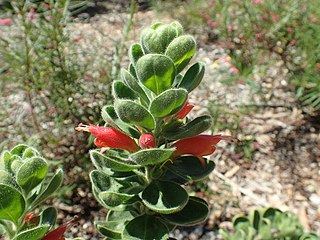
Eremophila decipiens, commonly known as slender fuchsia bush or narrow-leaved fuchsia bush is a flowering plant in the figwort family, Scrophulariaceae and is endemic to an area extending from the south-west of Western Australia to southern parts of South Australia. It is low, sprawling shrub with lance-shaped leaves and red, orange or yellow flowers on a long, S-shaped stalk.
Eremophila appressa, commonly known as wispy poverty bush, is a plant in the figwort family, Scrophulariaceae and is endemic to two remote locations in the central west of Western Australia. Its most unusual feature is its leaves which, at least when young, are less than 2.5 mm (0.1 in) long and 1 mm (0.04 in) wide and are glued to the stem by resin.
Eremophila aureivisca, also known as Rason poverty bush, is a flowering plant in the figwort family, Scrophulariaceae and is endemic to a small area in the south-east of Western Australia. It is a shrub with narrow, sticky, shiny leaves and pale purple flowers, known only from the edge of Lake Rason but may be more widely distributed in this remote area.
Eremophila cryptothrix is a flowering plant in the figwort family, Scrophulariaceae and is endemic to the Pilbara region of Western Australia. It is a shrub with sticky stems due to the presence of resin, narrow leaves, coloured sepals and white, pale pink or pale blue flowers.

Eremophila labrosa is a flowering plant in the figwort family, Scrophulariaceae and is endemic to Western Australia. It is a shrub with many hairy branches arising from near ground level, narrow, hooked leaves and mauve and blue flowers.
Eremophila lucida, commonly known as shining poverty bush, is a flowering plant in the figwort family, Scrophulariaceae and is endemic to Western Australia. It is an erect shrub with sticky, shiny leaves and branches and with flowers that are either red with darker red blotches inside or cream-coloured without spots or blotches.
Eremophila pallida is a flowering plant in the figwort family, Scrophulariaceae and is endemic to Western Australia. It is a small, spreading shrub with hairy stems, leaves with a few serrations and reddish purple to violet flowers.
Eremophila petrophila is a flowering plant in the figwort family, Scrophulariaceae and is endemic to Western Australia. It is a tall, erect, open shrub with rough branches, narrow, sticky leaves and pale lilac-coloured flowers.

Eremophila pinnatifida, commonly known as Dalwallinu eremophila is a flowering plant in the figwort family, Scrophulariaceae and is endemic to Western Australia. It is a spreading, rounded shrub with aromatic, deeply divided leaves and pale purple flowers which are white with purple spots inside. It is a rare plant, known only from a few areas near Perth.
Eremophila rostrata is a flowering plant in the figwort family, Scrophulariaceae and is endemic to Western Australia. It is an erect shrub with cylinder-shaped leaves, small sepals and glabrous, pink to deep red petals. There are two subspecies, both of which are critically endangered.

Eremophila rugosa is a flowering plant in the figwort family, Scrophulariaceae and is endemic to Western Australia. It is an erect shrub with sticky, shiny leaves and pink, purple or mauve flowers.
Eremophila setacea is a flowering plant in the figwort family, Scrophulariaceae and is endemic to Western Australia. It is an erect shrub with narrow, glabrous leaves, hairy sepals and light blue to purple petals.
Eremophila shonae is a flowering plant in the figwort family, Scrophulariaceae and is endemic to Western Australia. It is an erect shrub or a low spreading shrub, depending on subspecies and has very sticky branches and leaves due to the presence of large amounts of resin. The leaves are narrow and the flowers are mauve to purple and white inside with purple spots.
Eremophila simulans is a flowering plant in the figwort family, Scrophulariaceae and is endemic to Western Australia. It is an erect shrub with broad, serrated leaves and violet to purple flowers.

Eremophila splendens is a flowering plant in the figwort family, Scrophulariaceae and is endemic to Western Australia. It is a shrub which is mostly covered with a layer of glandular hairs and has red, unspotted flowers.

Eremophila spuria is a flowering plant in the figwort family, Scrophulariaceae and is endemic to Western Australia. It is an erect, open shrub with narrow leaves and blue, lilac, purple or white flowers and is a common and widespread species.
Eremophila succinea is a flowering plant in the figwort family, Scrophulariaceae and is endemic to Western Australia. It is an erect, broom-shaped shrub with sticky, narrow, hooked leaves, narrow, sticky sepals and hairy, pale purple or mauve petals.

Eremophila veneta, commonly known as metallic-flowered eremophila is a flowering plant in the figwort family, Scrophulariaceae and is endemic to Western Australia. It is a low, spreading, sticky shrub with dark green leaves and bluish-green petals.

Eremophila viscida, commonly known as varnish bush, is a flowering plant in the figwort family, Scrophulariaceae and is endemic to Western Australia. It is a large shrub or small tree with large green leaves which are sticky when young, colourful sepals and greenish-white petals with red to purple markings.
Eremophila viscimarginata is a flowering plant in the figwort family, Scrophulariaceae and is endemic to Western Australia. It is a small, erect, prickly shrub with hairy stems, small leaves, greenish-pink sepals and mauve petals.









